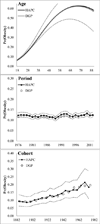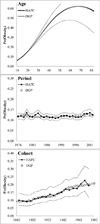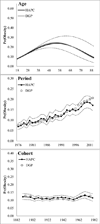Should age-period-cohort studies return to the methodologies of the 1970s?
- PMID: 25617033
- PMCID: PMC4357521
- DOI: 10.1016/j.socscimed.2015.01.011
Should age-period-cohort studies return to the methodologies of the 1970s?
Abstract
Social scientists have recognized the importance of age-period-cohort (APC) models for half a century, but have spent much of this time mired in debates about the feasibility of APC methods. Recently, a new class of APC methods based on modern statistical knowledge has emerged, offering potential solutions. In 2009, Reither, Hauser and Yang used one of these new methods - hierarchical APC (HAPC) modeling - to study how birth cohorts may have contributed to the U.S. obesity epidemic. They found that recent birth cohorts experience higher odds of obesity than their predecessors, but that ubiquitous period-based changes are primarily responsible for the rising prevalence of obesity. Although these findings have been replicated elsewhere, recent commentaries by Bell and Jones call them into question - along with the new class of APC methods. Specifically, Bell and Jones claim that new APC methods do not adequately address model identification and suggest that "solid theory" is often sufficient to remove one of the three temporal dimensions from empirical consideration. They also present a series of simulation models that purportedly show how the HAPC models estimated by Reither et al. (2009) could have produced misleading results. However, these simulation models rest on assumptions that there were no period effects, and associations between period and cohort variables and the outcome were perfectly linear. Those are conditions under which APC models should never be used. Under more tenable assumptions, our own simulations show that HAPC methods perform well, both in recovering the main findings presented by Reither et al. (2009) and the results reported by Bell and Jones. We also respond to critiques about model identification and theoretically-imposed constraints, finding little pragmatic support for such arguments. We conclude by encouraging social scientists to move beyond the debates of the 1970s and toward a deeper appreciation for modern APC methodologies.
Keywords: Age-period-cohort models; Body mass index; Cohort effects; Hierarchical modeling; Obesity epidemic; Random effects; Research methods; Social change.
Copyright © 2015 Elsevier Ltd. All rights reserved.
Figures




Comment in
-
Should age-period-cohort analysts accept innovation without scrutiny? A response to Reither, Masters, Yang, Powers, Zheng and Land.Soc Sci Med. 2015 Mar;128:331-3. doi: 10.1016/j.socscimed.2015.01.040. Epub 2015 Jan 28. Soc Sci Med. 2015. PMID: 25641207
References
-
- Baltes PB. Longitudinal and cross-sectional sequences in the study of age and generation effects. Hum Dev. 1968;11:145–171. - PubMed
-
- Bell A, Jones K. The impossibility of separating age, period and cohort effects. Soc Sci Med. 2013;93:163–165. - PubMed
-
- Bell A, Jones K. Another ‘futile quest’? A simulation study of Yang and Land’s Hierarchical Age-Period-Cohort model. Demographic Research. 2014a;30:333–360.
-
- Bell A, Jones K. Don’t birth cohorts matter? A commentary and simulation exercise on Reither, Hauser, and Yang’s (2009) age-period-cohort study of obesity. Soc Sci Med. 2014b;101:176–180. - PubMed
-
- Cutler DM, Glaeser EL, Shapiro JM. Why Have Americans Become More Obese? Journal of Economic Perspectives. 2003;17:93–118.
Publication types
MeSH terms
Grants and funding
LinkOut - more resources
Full Text Sources
Other Literature Sources
Medical
Miscellaneous

